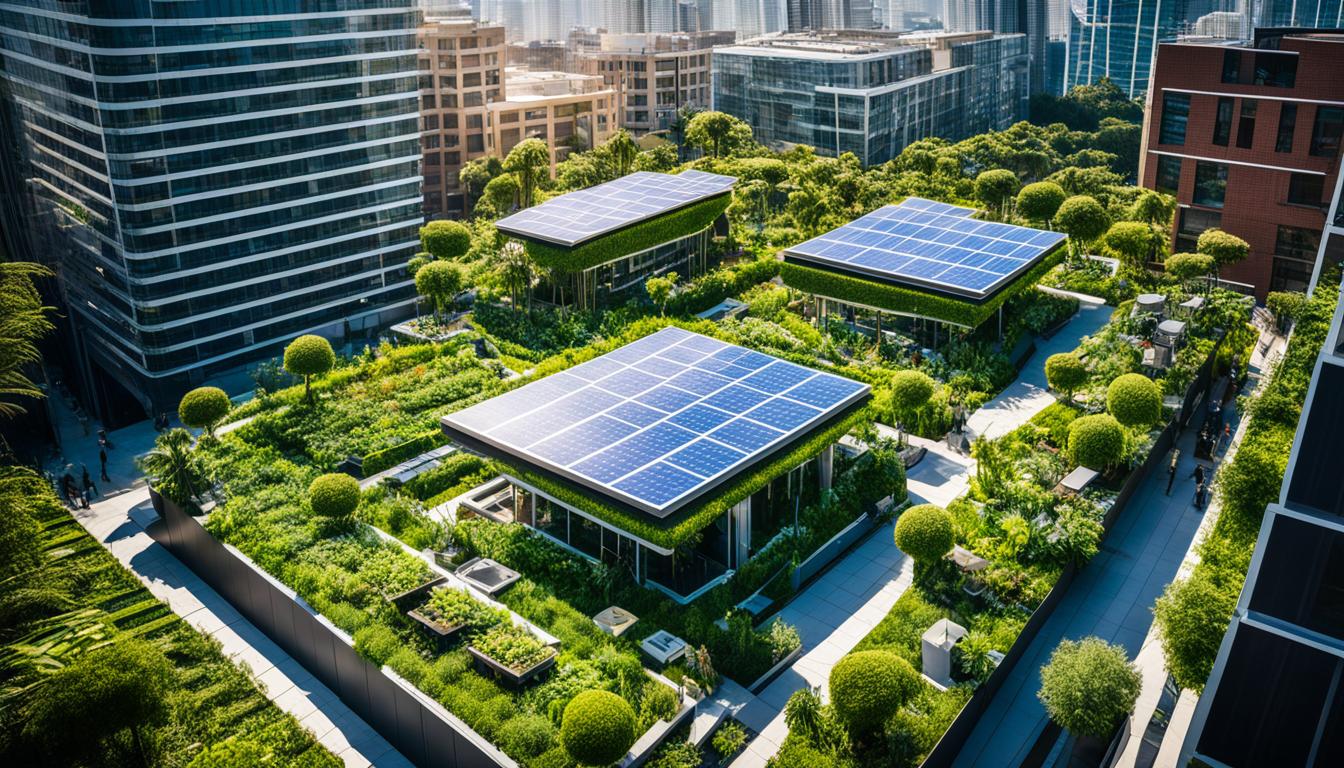Gardening has always been a beloved pastime, but in recent years, it has taken on a new significance. As people become more conscious of the environment and the importance of sustainable practices, the trend of green living has gained momentum. The year 2024 is set to be an exciting one for garden enthusiasts, with a host of new trends emerging. By staying ahead of these trends, you can create a garden that not only reflects the latest styles but also contributes to a greener lifestyle.
From vibrant colors to moody aesthetics, from essential pollinators to maximizing space, let’s explore the top garden trends for 2024 and find inspiration for your own outdoor living space.
Key Takeaways:
- Embrace hortifuturism by incorporating bold and bright colors into your garden.
- Create a gothic garden with moody aesthetics and eerie plants.
- Focus on essential pollinators like bees and butterflies by planting pollinator-friendly flowers.
- Maximize your space with vertical gardening using hanging and trailing plants.
- Promote sustainability by using native and carbon capturing plants in your garden.
Hortifuturism: Bold and Bright Colors for a Sci-Fi Garden
Garden Media predicts that hortifuturism will be a major trend in 2024. As gardeners look to create unique outdoor spaces, this trend embraces the use of vibrant and bold colors, bringing a sci-fi aesthetic to gardens. Hortifuturism moves away from cold metallic hues and embraces a bold and bright color palette.
One way to incorporate hortifuturism into your garden is through the use of terrariums. These enclosed ecosystems are not only visually stunning but also allow for the cultivation of exotic and eye-catching plants. Displaying terrariums in bold and bright colors can create a focal point in your garden, adding a sci-fi element to the overall design.
Survivalist gardens are another aspect of hortifuturism that gardeners can explore. These gardens focus on self-sufficiency, showcasing plants that can sustain and nourish. By incorporating neon-colored plants with foliage that has bright variegation, you can create a visually striking and futuristic garden that is both functional and beautiful.
Night gardens are also gaining popularity within hortifuturism. These gardens come alive at night, incorporating lighting techniques that accentuate the bold and bright colors of plants. Using uplighting and strategic placement of neon-colored plants, you can create a dramatic and otherworldly ambiance in your garden once the sun sets.
“Hortifuturism is all about stepping into the future and embracing bold, bright, and unconventional colors in your garden. It’s about creating a sci-fi inspired outdoor space that is both visually stunning and immersive, transporting you to another world.” – Garden Media
Incorporating hortifuturism into your garden allows you to tap into your creativity and create a unique and captivating outdoor space. Whether it’s through the use of terrariums, survivalist gardens, or night gardens, embracing bold and bright colors can bring a sci-fi garden experience right to your doorstep.
Gothic Gardens: Embracing Moody Aesthetics
In 2024, another trend emerges in the realm of garden aesthetics – the captivating allure of gothic gardens. Inspired by the moody aesthetics loved by Gen Z, this trend offers a unique twist on traditional landscapes. Embracing a darker, more dramatic ambiance, gothic gardens create an enchanting atmosphere that resonates with the ethereal and mysterious.
Unleashing Moody Magic
What sets gothic gardens apart is their ability to evoke a sense of intrigue and wonder. With eerie plants taking center stage amid whimsical compositions, these gardens invite exploration and contemplation. The use of gothic pottery and statuary adds an air of antiquity and mystique, creating a visual narrative that unfolds with each step.
Eerie plants, gothic pottery and statuary, and evening experiences all come together to cultivate a spellbinding atmosphere in gothic gardens.
An Evening to Remember
One of the signature features of gothic gardens is their ability to transform as the sun sets. Evening experiences, such as uplighting trees or incorporating dimly lit pathways, further enhance the mystical ambiance. As daylight fades, the gothic elements are illuminated, casting shadows and accentuating the enchantment that resides within the garden’s dark corners.
The Beauty of Decay
Gothic gardens celebrate the beauty found in the imperfections of nature. Withered plants and faded blooms are cherished for their captivating allure, symbolizing the transitory nature of life. This appreciation for the cycle of growth and decay adds depth and complexity to the garden, embracing the melancholic beauty that can be found even in the most withered petals.
Step into the world of gothic gardens and let the moody aesthetics captivate your senses. Explore the eerie plants, intricate gothic pottery, and statuary that transport you to a realm of shadowy beauty. Experience the enchantment of evening moments and embrace the faded blooms that tell stories of life’s fleeting nature.
Essential Pollinators: Focus on Bees and Butterflies
Garden Media has identified essential pollinators as a major trend in 2024. In addition to being popular interior décor motifs, bees and butterflies are now captivating the world of gardening. This trend highlights the significance of pollinator plants in supporting the survival of these essential creatures. Bee balm, asters, and goldenrod are among the top choices for attracting and nourishing bees and butterflies.
Bees and butterflies play a vital role in pollination, ensuring the production of fruits, vegetables, and flowers in our gardens. By cultivating pollinator plants, we can create beautiful and functional habitats that support these essential pollinators.
Bees: Nature’s Tiny Gardeners
Bees are diligent workers and play a crucial role in pollinating plants. They tirelessly shuttle from flower to flower, collecting nectar and pollen as they go. By doing so, they transfer pollen between the male and female parts of flowers, enabling fertilization and fruit production. Without bees, many of our favorite fruits and vegetables would be in short supply.
One key strategy for attracting bees is to plant bee balm (Monarda), a stunning perennial known for its vibrant blooms and ability to lure these buzzing creatures. With its brilliant colors and nectar-rich flowers, bee balm is like a beacon for bees.
Other plants that bees find irresistible include asters and goldenrod. These flowering plants provide abundant sources of nectar and pollen, ensuring a steady food supply for bees throughout the season.
Butterflies: Graceful Visitors
Butterflies bring beauty and grace to our gardens with their delicate wings and vibrant colors. Like bees, they also play a crucial role in pollination. As they flit from flower to flower, they inadvertently transfer pollen, allowing plants to reproduce.
Asters, with their daisy-like blooms, are a favorite among butterflies. These perennial plants provide not only nectar but also a place for butterflies to lay their eggs and for caterpillars to feed. Goldenrod, with its clusters of bright yellow flowers, is another excellent choice for attracting butterflies to your garden.
By creating a welcoming environment filled with pollinator plants, we can support bees and butterflies while enjoying the beauty and tranquility of our gardens. Let’s embrace the essential pollinators trend and become champions for these incredible creatures!
| Essential Pollinator Plants | Description |
|---|---|
| Bee Balm | A stunning perennial with vibrant blooms that attract bees and provide them with a rich source of nectar. |
| Asters | These daisy-like flowers provide nectar for butterflies and serve as a food source for caterpillars. |
| Goldenrod | Clusters of bright yellow flowers that attract both bees and butterflies, providing them with ample nectar. |
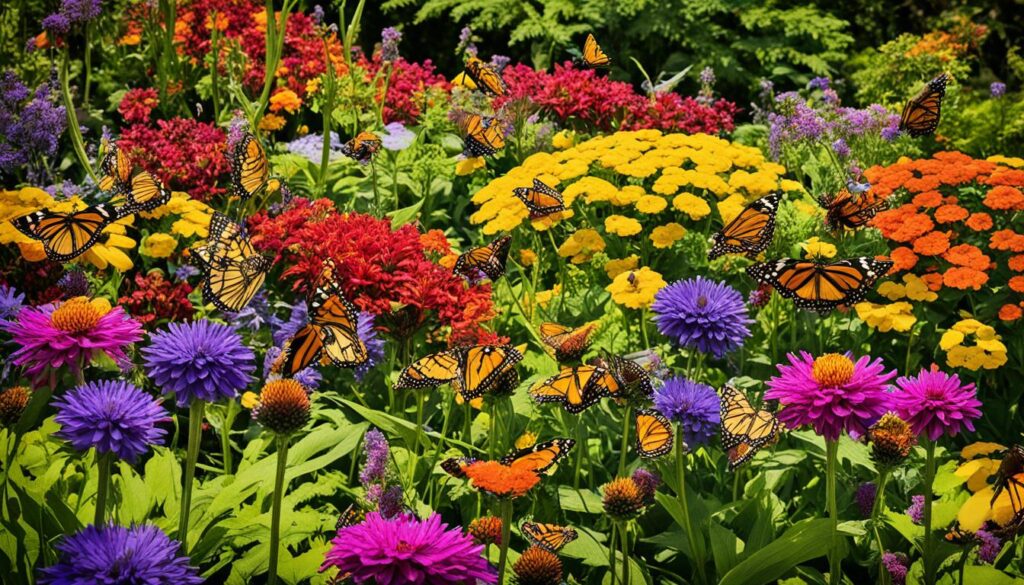
Vertical Gardening: Maximizing Space with Containers
Container gardening is gaining popularity, especially in urban areas where space is limited. According to the report, there has been a significant increase in households practicing container gardening. One exciting application of this trend is vertical gardening, which allows gardeners to make the most of their space by utilizing hanging and trailing plants.
Vertical gardening is an innovative technique that involves growing plants upwards rather than outwards, making it perfect for small gardens, balconies, and even indoor spaces. By using hanging planters, trellises, and wall-mounted containers, plant enthusiasts can create lush green walls, living artwork, and efficient use of space.
The Benefits of Vertical Gardening
- Maximizing Space: Vertical gardening is an excellent solution for small spaces. It allows gardeners to grow a variety of plants without taking up precious floor space.
- Easy Maintenance: By growing plants at eye level, vertical gardens are more accessible for watering, pruning, and harvesting. This makes maintenance tasks more convenient and enjoyable.
- Improved Air Quality: Vertical gardens not only add beauty to the surroundings but also act as natural air purifiers, filtering out toxins and increasing oxygen levels.
- Enhanced Privacy: Vertical gardening can create a natural screen, providing privacy and seclusion in outdoor spaces.
- Reduced Pest Problems: Elevated plants in vertical gardens often have fewer issues with pests and diseases, as they are further away from the ground where many pests reside.
“Vertical gardening allows me to transform my small balcony into a lush oasis. I love the fact that I can grow a variety of plants without sacrificing precious space. It’s a game-changer for urban gardeners like me.”
Whether it’s beautiful flowering vines, cascading ivy, or a variety of herbs, the possibilities are endless when it comes to vertical gardening. The key is to choose plants that are well-suited for containers and thrive in the conditions of your space.
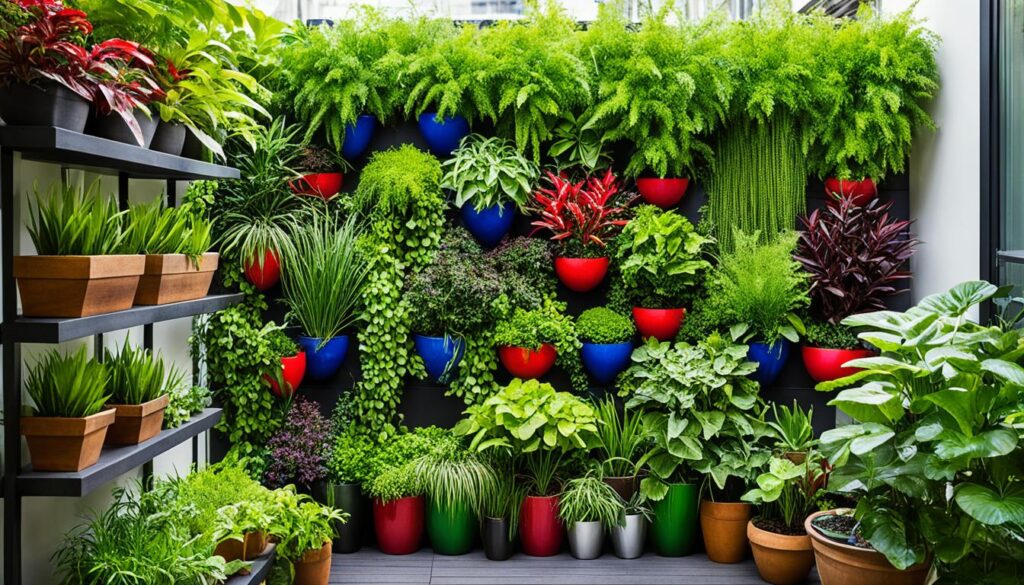
| Plants for Vertical Gardening | Light Requirements | Watering Needs |
|---|---|---|
| Hanging Petunias (Petunia spp.) | Full Sun | Regular watering, keep soil moist |
| English Ivy (Hedera helix) | Partial Shade to Full Sun | Water when top inch of soil is dry |
| Trailing Rosemary (Rosmarinus officinalis) | Full Sun | Allow soil to dry between waterings |
| Spider Plant (Chlorophytum comosum) | Indirect Sunlight to Partial Shade | Keep soil evenly moist |
| Vegetables: Cherry Tomatoes, Peppers | Full Sun | Regular watering, keep soil consistently moist |
Sustainability Efforts: Native and Carbon Capturing Plants
In today’s ever-changing world, sustainability has become a crucial aspect of our lives. This includes our gardens, where we can make a positive impact on the environment through our choices. The 2023 Chelsea Flower Show exemplified this dedication to sustainability, showcasing a myriad of exhibits centered around efficient community gardens and sustainable practices.
One of the key aspects of sustainable gardening is the use of native plants. These plants are naturally adapted to the local climate, requiring less water, fertilizer, and pesticides. By incorporating native plants into our gardens, we can create a harmonious environment that supports local wildlife and reduces our ecological footprint.
Another important aspect of sustainability is the incorporation of carbon capturing plants into our garden design. These plants have the ability to sequester carbon dioxide from the atmosphere, helping to mitigate the effects of climate change. By selecting carbon capturing plants for our gardens, we can contribute to the global effort to reduce greenhouse gas emissions.
When it comes to garden aesthetics, there has been a shift away from highly curated gardens towards a more natural and diverse approach. Curated gardens often require significant resources and maintenance to maintain their pristine appearance. In contrast, a less curated garden allows for a more organic flow of plants and encourages biodiversity. This creates a vibrant and dynamic garden that is not only visually appealing but also provides essential habitats for wildlife.
Benefits of Native and Carbon Capturing Plants:
- Reduced water usage
- Decreased dependency on fertilizers and pesticides
- Support for local wildlife and pollinators
- Contribution to carbon sequestration
- Enhanced biodiversity
By embracing sustainability efforts and incorporating native and carbon capturing plants into our gardens, we can create beautiful and eco-friendly spaces that have a positive impact on the environment. As gardeners, we have the power to make a difference and inspire others to join the movement towards a greener future.
Take a look at the image below to see an example of a curated garden that incorporates native and carbon capturing plants:
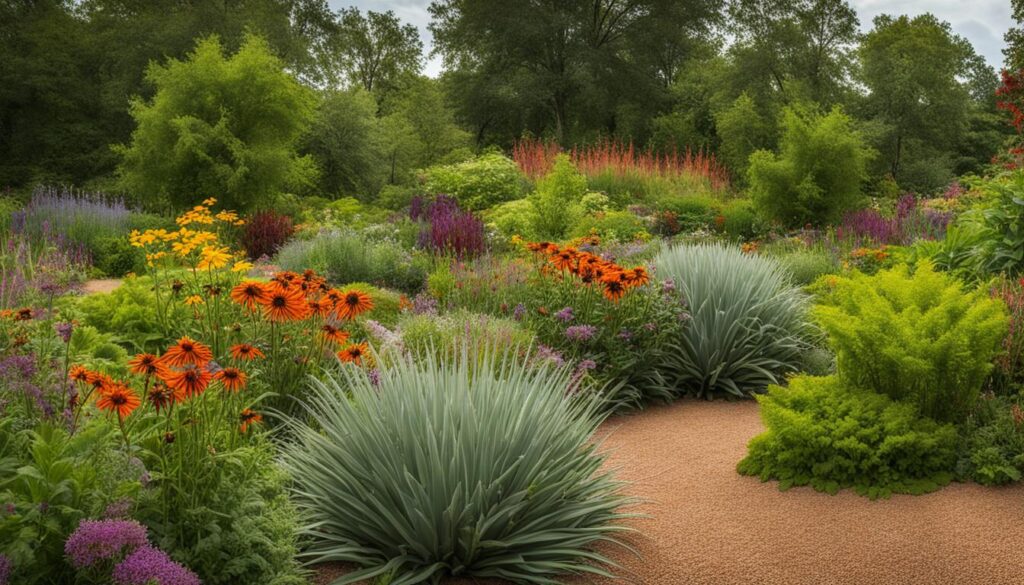
| Plant | Type | Native Origin | Carbon Capturing Capability |
|---|---|---|---|
| Oak Tree | Tree | North America | High |
| Milkweed | Perennial | North America | Medium |
| Blazing Star | Perennial | North America | Medium |
| Goldenrod | Perennial | North America | Medium |
| Prairie Dropseed | Grass | North America | Low |
By selecting a combination of trees, perennials, and grasses that are native to North America, we can create a curated garden that not only enhances the beauty of our outdoor spaces but also contributes to the conservation of our planet.
Enhancing with Edimentals: Edible and Ornamental Plants
Edimentals, a combination of the words “edible” and “ornamentals,” are an exciting trend that is taking gardens by storm. These plants serve a dual purpose, providing both aesthetic beauty and delicious flavors to elevate your garden experience. Whether you have a traditional vegetable garden or a sprawling landscape, incorporating edimentals adds a touch of versatility and creativity.
Perennials, shrubs, and even trees can be enhanced with edimentals, offering a range of options to suit different garden styles and tastes. These plants not only provide color, texture, and form but also offer the opportunity to harvest fresh produce right from your backyard.
One example of an edimental is the hibiscus plant. With its vibrant flowers and appealing flavor, hibiscus can be used in both culinary creations and as a stunning ornamental in gardens. Its edible petals can be steeped to make tea or infused into various recipes, while its showy blooms add a splash of color to any landscape.
Another popular choice is the rosemary shrub, known for its aromatic fragrance and versatile culinary uses. Rosemary can be trimmed into topiaries, creating a visually appealing focal point in your garden. At the same time, its flavorful leaves can be used to enhance a wide array of dishes, from roasted meats to infused oils.
“Integrating edimentals into your garden allows you to create a harmonious blend of natural beauty and practicality,” says Julia Thompson, a renowned horticulturist.
As Julia puts it, “Edimentals provide an opportunity to turn your garden into a true feast for the senses. They offer a chance to connect with nature while indulging in fresh, homegrown flavors.”
The Benefits of Edimentals
Adding edimentals to your garden brings a multitude of benefits. Here are a few reasons why you should consider enhancing your outdoor space with these edible and ornamental plants:
- Multi-functional: Edimentals serve both a visual and culinary purpose, making them a valuable addition to any garden.
- Space-saving: With edimentals, you can make the most of your gardening area, as plants serve dual functions without the need for separate spaces.
- Seasonal interest: These plants offer year-round beauty, with stunning blooms and foliage during different seasons.
- Encourages biodiversity: Edimentals can attract pollinators and other wildlife, fostering a healthy and vibrant ecosystem in your garden.
If you’re ready to enhance your garden with edimentals, take a look at the table below for a selection of popular choices:
| Plant | Description |
|---|---|
| Lavender | Aromatic flowers that can be used in cooking and as a natural air freshener. |
| Nasturtium | Colorful flowers and peppery leaves that add a unique flavor to salads and other dishes. |
| Calendula | Bright orange and yellow petals that can be dried and used as a natural dye or infused into oils for skincare. |
| Crabapple | Attractive fruit-bearing trees that provide beautiful blooms in spring and can be used for jams and jellies. |
As you embark on your edimental journey, remember to choose plants that thrive in your local climate and garden conditions. This ensures that both their ornamental and edible qualities will flourish. So why not elevate your garden to new heights by embracing edimentals? Enjoy the beauty, flavors, and countless possibilities they bring to your gardening experience.
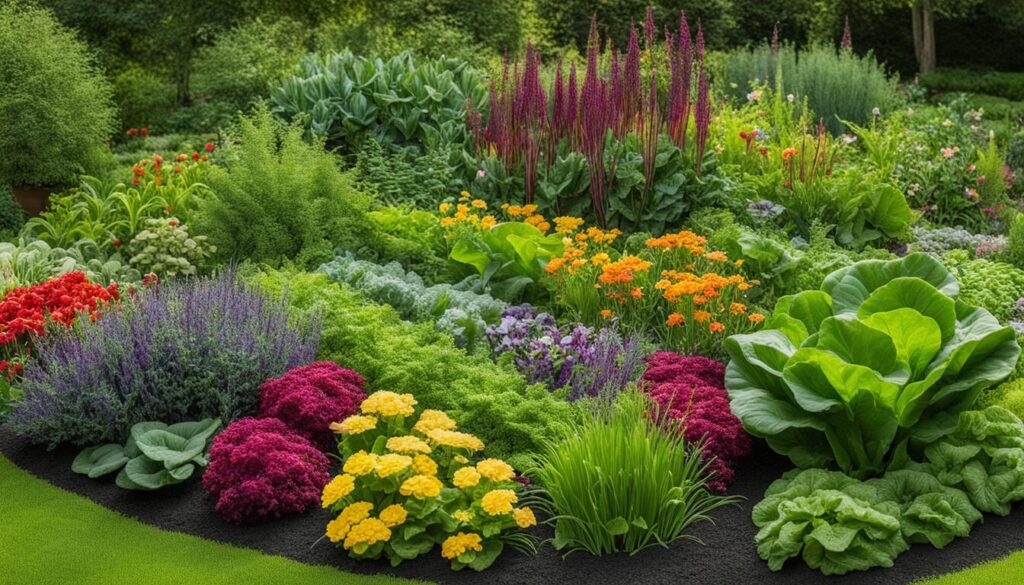
Exploring Naturalistic Planting: A Softer, Wild Aesthetic
Naturalistic planting, also known as the New Perennial Movement, is gaining momentum as a mainstream design aesthetic in gardening. This trend embraces a softer, wild aesthetic, moving away from traditional formal gardens. It celebrates the beauty of nature and focuses on creating plant communities that blend harmoniously with the surrounding environment.
The New Perennial Movement emphasizes the use of native plants, which are well-suited to the local climate and require minimal maintenance. These plants thrive in their natural habitat and provide essential food and shelter for local wildlife and pollinators. By incorporating native plants into your garden, you are not only creating a beautiful landscape but also contributing to the preservation of local ecosystems.
A key principle of naturalistic planting is the diversity of plants. By including a wide variety of species, you can create intricate and dynamic plant compositions that change throughout the seasons. This diversity not only adds visual interest but also provides a more resilient and sustainable ecosystem in your garden.
The benefits of naturalistic planting extend beyond aesthetics. This style of gardening promotes biodiversity and supports local wildlife populations, including birds, bees, butterflies, and beneficial insects. The diverse range of plants provides food and habitats for these creatures, contributing to a thriving and balanced ecosystem.
One of the main goals of naturalistic planting is to create a garden that feels like an extension of the natural landscape. By following this approach, you can achieve a sense of harmony and tranquility in your outdoor space. It’s about creating a nurturing environment that invites you to connect with nature and enjoy its beauty.
Key Features of Naturalistic Planting
Incorporating naturalistic planting into your garden involves several key features:
- Use of native plants
- Diversity of plant species
- Blending with the surrounding environment
- Creating habitats for wildlife and pollinators
By incorporating these features into your garden, you can create a unique and sustainable outdoor space that supports local ecosystems and enhances your connection with nature.
An Example of a Garden Designed with Naturalistic Planting
To illustrate the concept of naturalistic planting, let’s take a look at an example garden:
| Plant | Characteristics |
|---|---|
| Asclepias tuberosa | A native perennial with vibrant orange flowers that attract butterflies |
| Liatris spicata | Tall spiky flowers in shades of purple, attracting bees and butterflies |
| Echinacea purpurea | Large, cone-shaped flowers in shades of pink, purple, and white, loved by bees |
| Fragaria virginiana | Low-growing strawberry plants that provide ground cover and food for birds |
“Naturalistic planting allows you to create a garden that not only looks beautiful but also contributes to the well-being of the local ecosystem. By embracing native plants and promoting biodiversity, you can transform your outdoor space into a haven for wildlife and pollinators.”
By embracing naturalistic planting in your garden, you can create a visually stunning and environmentally friendly outdoor oasis. This trend not only adds beauty to your surroundings but also promotes sustainability and supports local ecosystems.
Conclusion
In 2024, the garden trends will revolve around hortifuturism, gothic aesthetics, essential pollinators, vertical gardening, and sustainability efforts. These trends reflect a growing interest in vibrant colors, moody landscapes, beneficial insects, maximizing space, and promoting environmental sustainability. By staying ahead of these trends, we can create stylish and eco-friendly outdoor living spaces.
Gardeners who embrace hortifuturism will incorporate bold and bright colors into their gardens, creating a sci-fi vibe with terrariums, neon-colored plants, and foliage with bright variegation. Those who are drawn to gothic aesthetics can create moody landscapes with eerie plants, gothic pottery and statuary, and evening experiences like uplighting trees.
Essential pollinators, such as bees and butterflies, will be a focus in 2024. By cultivating pollinator plants like bee balm, asters, and goldenrod, we can contribute to the conservation and well-being of these important creatures. Vertical gardening will also gain popularity as more people maximize their limited space with hanging and trailing plants.
Moreover, sustainability efforts will continue to play a crucial role in gardening. By prioritizing native and carbon-capturing plants, we can create curated gardens that are not only visually appealing but also benefit the environment. These garden trends of 2024 provide inspiration for those seeking to create beautiful and sustainable outdoor spaces.
FAQ
What is hortifuturism?
Hortifuturism is a garden trend that embraces vibrant and bold colors, replacing cold metallic hues. It includes the use of terrariums, survivalist gardens, night gardens, neon-colored plants, and foliage with bright variegation.
What are gothic gardens?
Gothic gardens are a trend that taps into Gen Z’s love for dramatic landscapes and embraces a moody aesthetic. They involve the use of eerie plants, gothic pottery and statuary, evening experiences like uplighting trees, and incorporating withered plants and faded blooms.
Why are essential pollinators important?
Essential pollinators, such as bees and butterflies, are important for both interior décor motifs and in gardens. This trend emphasizes the importance of the plants that feed these pollinators and encourages the cultivation of pollinator plants such as bee balm, asters, and goldenrod.
What is vertical gardening?
Vertical gardening is a rising trend, especially in urban areas. It involves maximizing space by using hanging and trailing plants, allowing people to practice container gardening in a vertical arrangement.
What are sustainability efforts in gardens?
Sustainability efforts in gardens refer to a shift towards less curated gardens and a focus on native and carbon capturing plants. This trend aims to promote environmental sustainability by using plants that are suited to the local ecosystem and help capture carbon dioxide.
What are edimentals?
Edimentals are plants that are both edible and ornamental. They are gaining popularity in gardens as they serve multiple functions and can be incorporated into traditional vegetable gardens. Edimentals include perennials, shrubs, and even trees, and they provide color, texture, and form in addition to being edible.
What is naturalistic planting?
Naturalistic planting, also known as the New Perennial Movement, is a mainstream design aesthetic. This trend embraces a softer, wild aesthetic and focuses on planting native plants and creating plant communities that blend with surrounding nature. It emphasizes a diversity of plants that support wildlife and pollinators.
What are the main garden trends in 2024?
The main garden trends in 2024 include hortifuturism, gothic gardens, essential pollinators, vertical gardening, and sustainability efforts. These trends reflect a growing interest in vibrant colors, moody landscapes, beneficial insects, maximizing space, and promoting environmental sustainability.
How can I stay ahead with the latest garden trends in 2024?
To stay ahead with the latest garden trends in 2024, you can follow the recommendations from Garden Media’s 2024 garden trends report. By staying informed about hortifuturism, gothic gardens, essential pollinators, vertical gardening, and sustainability efforts, you can create stylish and eco-friendly outdoor living spaces.

